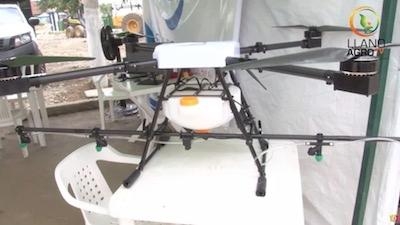Wed, Aug 22, 2018
Ten Drones Being Tested In Nariño Province
The Colombian government is testing a fleet of 10 drones to destroy coca plants that are used in the production of cocaine.

Drone DJ relays a report from the Wall Street Journal which indicates that the new President of Colombia, Iván Duque, prefers using drones over manned aircraft to protect neighboring crops from damage.
The tests are being conducted in the southwestern portion of Nariño province. The drones carry the herbicide Glyphosate, a defoliant, and spray the coca plants with far greater accuracy than could be achieved using more traditional methods. The previous President of Colombia, Juan Manuel Santos, had halted spraying by 14 crop duster airplanes after local farmers filed lawsuits who were concerned about their health. Glyphosate has been linked to some cancers by the World Health Organization.
The U.S. EPA has said that glyphosate is "unlikely" to cause cancer. The chemical has been part of a $10 billion foreign aid package called "Plan Colombia". Use of the chemical reduced the country's coca fields from 470,000 acres in 2001 to 193,000 acres in 2012. But by 2017, the acreage had again increased 160 percent to 516,000 acres.
The drones have been provided by Fumi Drones SAS. German Huertas, director of operations at Fumi Drone says that the aircraft can eliminate about 90 percent of the crops on every acre of coca plants. They also fly lower to the ground, and do not pose a safety hazard to pilots flying close to the ground, Huertas said. The company is also training local police to fly the aircraft.
The downside is that the drones carry a much smaller load of the defoliant than a crop duster, and police must cordon off an area to be sprayed to prevent local farmers from being exposed or cocaine manufacturers from shooting them out of the air. There are also a large number of landmines buried in many regions from a long rebel conflict in Colombia, which can pose additional threats to soldiers and drone pilots.
(Image provided by Llano AgroTV)
More News
Aero Linx: JAARS Nearly 1.5 billion people, using more than 5,500 languages, do not have a full Bible in their first language. Many of these people live in the most remote parts of>[...]
'Airplane Bounced Twice On The Grass Runway, Resulting In The Nose Wheel Separating From The Airplane...' Analysis: The pilot reported, “upon touchdown, the plane jumped back>[...]
"Burt is best known to the public for his historic designs of SpaceShipOne, Voyager, and GlobalFlyer, but for EAA members and aviation aficionados, his unique concepts began more t>[...]
"Polaris Dawn, the first of the program’s three human spaceflight missions, is targeted to launch to orbit no earlier than summer 2024. During the five-day mission, the crew >[...]
There Are SO Many Ways To Get YOUR Aero-News! It’s been a while since we have reminded everyone about all the ways we offer your daily dose of aviation news on-the-go...so he>[...]
 ANN's Daily Aero-Linx (05.04.24)
ANN's Daily Aero-Linx (05.04.24) NTSB Final Report: Quest Aircraft Co Inc Kodiak 100
NTSB Final Report: Quest Aircraft Co Inc Kodiak 100 Aero-News: Quote of the Day (05.04.24)
Aero-News: Quote of the Day (05.04.24) Aero-News: Quote of the Day (05.05.24)
Aero-News: Quote of the Day (05.05.24) Read/Watch/Listen... ANN Does It All
Read/Watch/Listen... ANN Does It All



